Affiliate disclosure: This post may contain affiliate links. Please see our Privacy Policy.
Canning onions in a pressure canner is an approved preservation method, but there’s a specific technique to follow. Learn how to can plain onions, without pickling, and how to modify the recipe for canning french onion soup in beef stock.
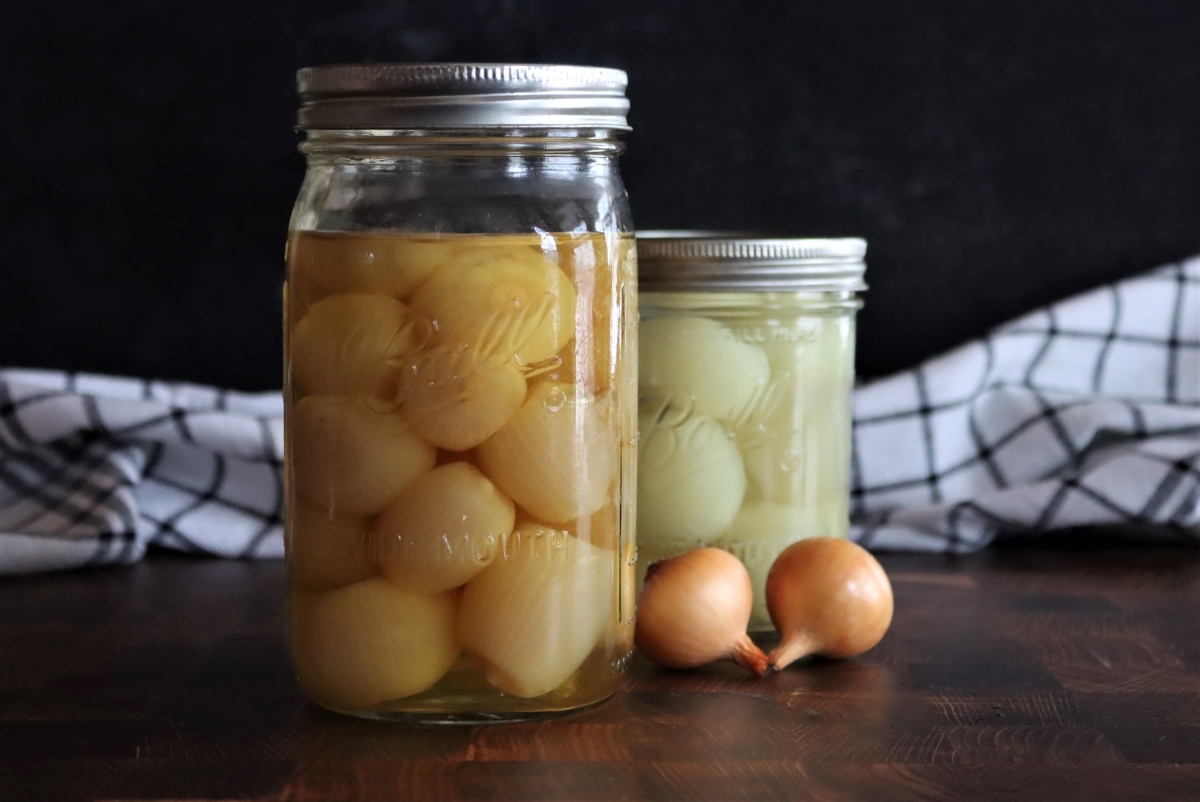
Honestly, I’d never really thought about canning onions, it just didn’t seem necessary. We usually grow storage onion varieties that’ll easily keep 6 to 8 months in our basement, ensuring a supply until the following year.
The thing is, onions need to be cured properly before storage so they’ll develop a protective papery husk, and dry out their wet stem that’s liable to mold otherwise. They’re harvested large, so there’s still plenty of onion left after the curing process dried out the outer layers.
What happens to small, bruised, or otherwise imperfect onions? They’re usually used up early rather than stored, as there usually aren’t all that many.
This year, my overzealous 5-year-old garden helper decided to harvest several hundred onions a few months early. Right in the middle of the summer, I’d sent her out to grab a few fresh onions for dinner…she got a bit carried away, harvesting whole beds and leaving them laying there on the soil until she found the perfect one.
About 20 minutes later she came back in, carrying dinner onions. I didn’t notice the rest of the dug up onions until they’d lain there in the sun for several days, long past re-planting, and definitely in no shape for curing.
It was way more than we could possibly use before they spoiled, and I wasn’t about to sacrifice the freezer space that we desperately needed to store sweet summer berries.
Time to learn how to can onions!
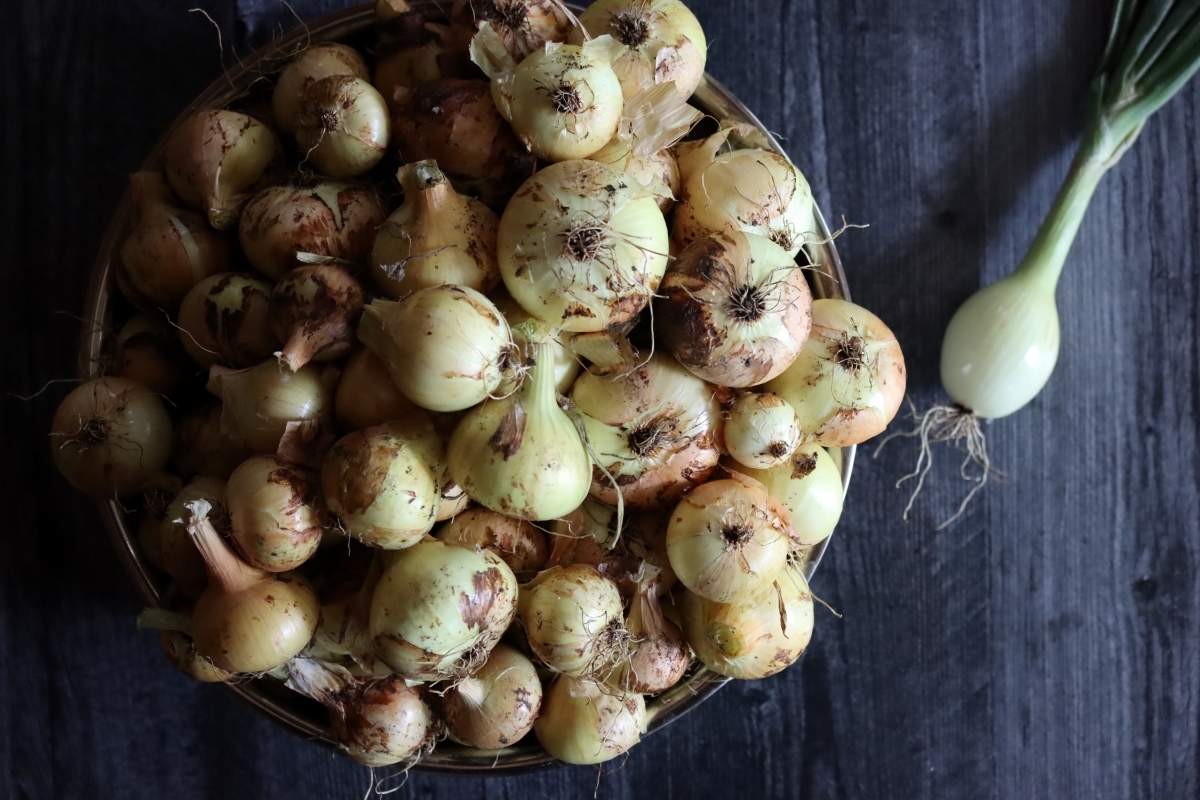
There are actually a few reasons to can onions, beyond the depredations of an overzealous kindergartener.
Not everyone has a cool basement storage location, especially people living out west where basements don’t really exist and it’s hot much of the year (indoors and out). In that case, sauteeing them then packing them into the freezer is a good second choice.
That assuming you have a lot of extra freezer space, but really that’s best used for storing meat or a summer’s worth of frozen berries. Canning provides you a good option without taking up freezer space.
Even if you never attempt to can onions, knowing that you can is important. Why?
The national center for food preservation put out a “choose your own adventure” pressure canner soup recipe, that allows you to make up your own recipe and safely can it.
The only caveat is that all the ingredients must be safe for canning individually. You can’t add eggs, flour, or pasta to the soup, but since there is a safe canning recipe for onions, you’re able to add those if you wish.
In theory, since there is a canning recipe for onions, you could use that same “choose your own adventure” soup canning instructions to can just onions alone in a jar (with beef stock, veggie stock or water). I’ll walk you through that option at the end, after discussing the specific tested recipe for pressure canning onions.
(If you’re not familiar with pressure canning, I’d recommend you read this beginner’s guide to pressure canning before you get started.)
How to Can Onions
The instructions for canning onions are rather specific, not necessarily because this is the only possible method, but simply because it’s the only “tested” method.
In the US, safe canning recipes are determined by the national center for food preservation in coordination with agricultural extensions. They only have so many resources, and they can’t test every possible permutation. The cooperative extension at Clemson College tested a recipe for canning whole small onions, about 1 inch in diameter.
“Onions are low acid foods with a pH of 5.3 to 5.85. Thus, if they are to be canned, they must be pressure canned for safety. This tested recipe is specific for onions of 1-inch diameter or less…
- Wash and peel onions.
- Cover with boiling water, bring to a boil, and boil for 5 minutes.
- Pack onions into hot jars, leaving 1-inch headspace.
- Add ½ teaspoon salt to pints or 1 teaspoon to quarts, if desired.
- Fill jar to within 1 inch from top with boiling water.
- Remove air bubbles leaving 1-inch headspace. Wipe jar rims and adjust lids to fingertip tight.
- Process pints or quarts in a pressure canner for 40 minutes. At altitudes of 0 to 2,000 feet, process jars at 11 pounds pressure in a dial gauge canner; in a weighted gauge canner, process jars at 10 pounds pressure at altitudes of 0 to 1,000 feet and at 15 pounds pressure for altitudes above 1,000 feet.”
This is the process I’m going to test with my small onions, mostly to see how they turn out.
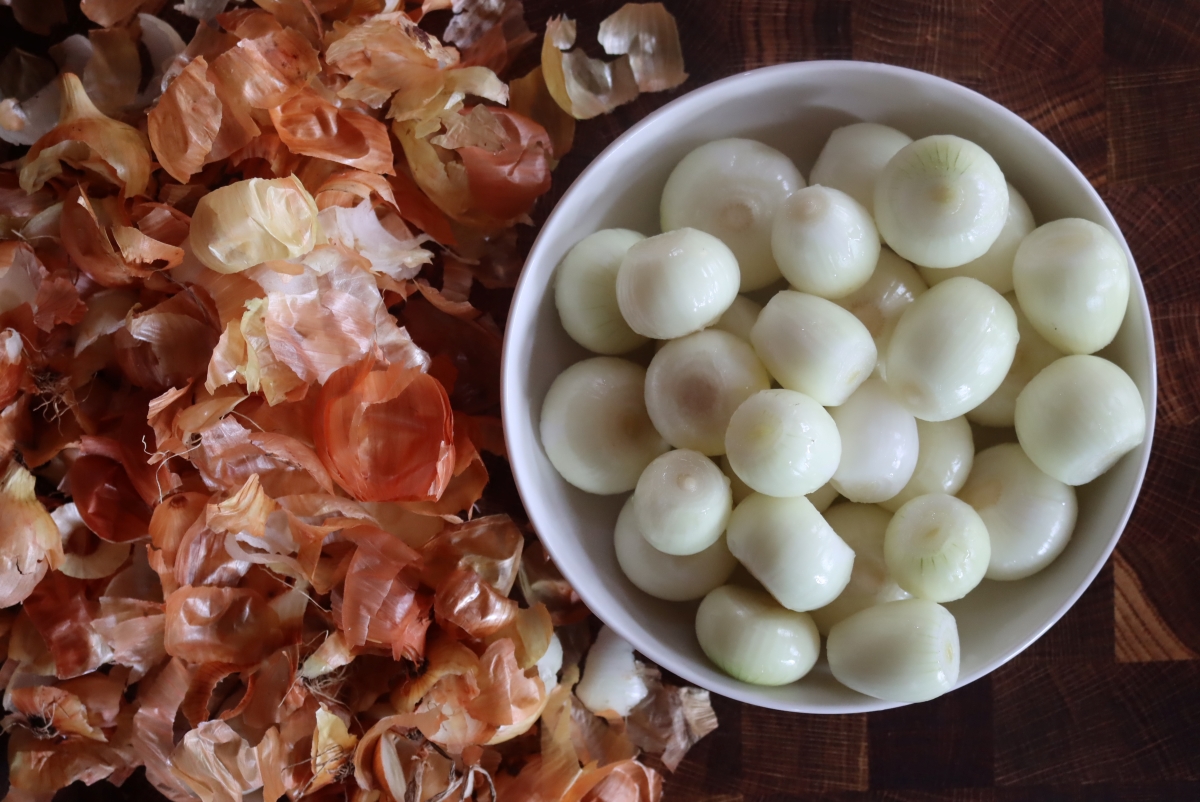
After the onions are peeled, they’re then boiled for 5 minutes and then packed into jars leaving 1-inch headspace. They’re then pressure canned for 40 minutes, with a pressure adjusted to altitude (see above).
I wanted to see how they’d change in the canner, so I filled two jars with onions that had been boiled 5 minutes as described. I canned just one of them (the quart pictured below) and left the second jar alone without actually canning it.
As you can see, the onions that I canned browned considerably in the canner as the sugars in their tissues caramelized. I was actually pretty pleased by this because I hoped to be able to use them as a french onion soup base later and caramelization is ideal.
(You can also see that the jar siphoned a bit, losing liquid. That’s fine and just a cosmetic issue, not something that impacts canning safety so long as the jar is sealed.)
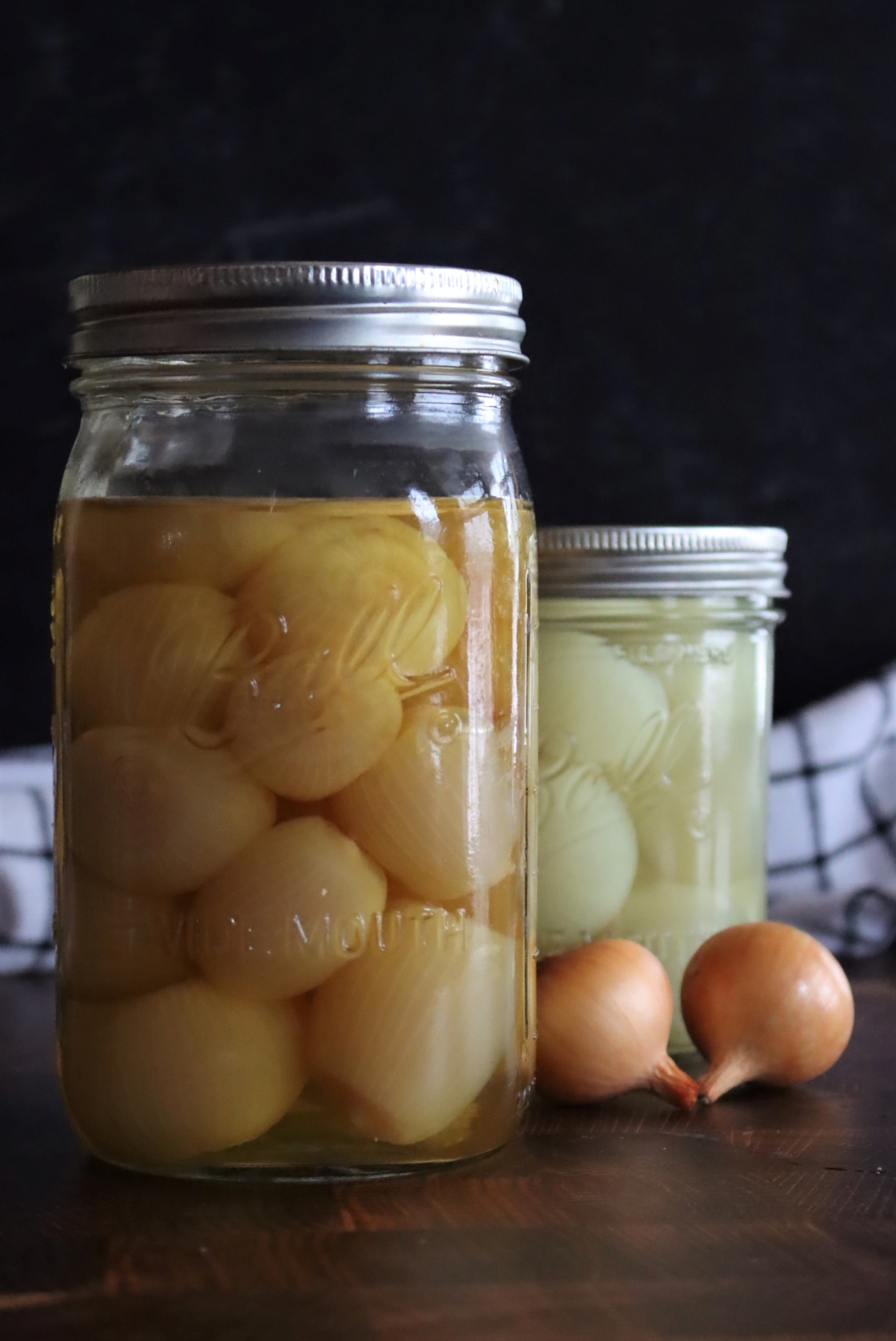
Using Home Canned Onions
So now that I have a jar of home-canned onions, I wanted to see how they’d taste.
They’re quite soft, as you’d imagine after 40 minutes in a pressure canner. They’re a lot like onions that have been in a slow cooker with a pot roast all day. Flavorful, slightly sweet, and onion-y of course.
I pulled them out of the jar and chopped them up to make french onion soup, mixing the jar liquid with a jar of home-canned beef stock as the base.
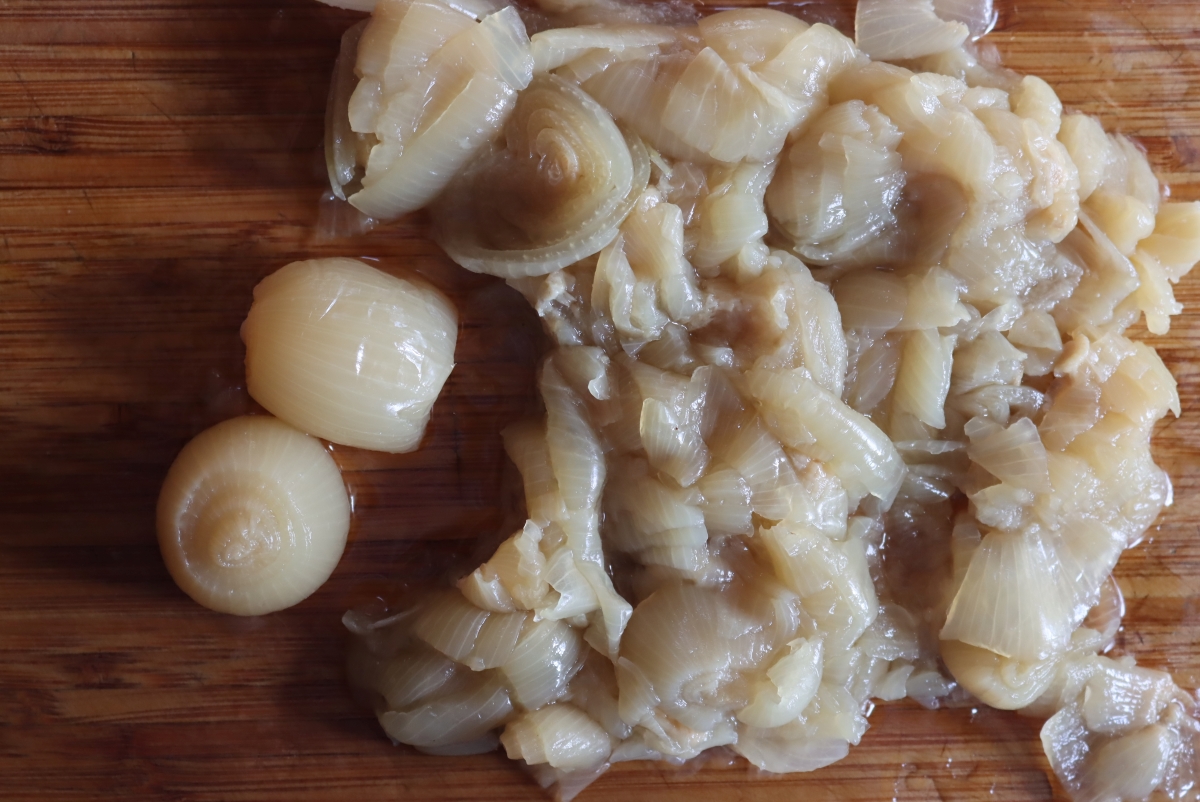
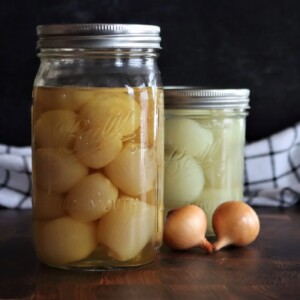
Canning Onions
Ingredients
- Small onions, about 1-inch in diameter
- Boiling water
- Salt, optional, 1/2 teaspoon for pint jars or 1 teaspoon for quart jars
Instructions
- Start by washing and peeling the onions. If you’re using small onions (about 1-inch in diameter), they’re perfect for this process. Larger onions will need to be cut into halves or quarters to fit in jars more easily.
- Place the peeled onions into a pot and cover them with boiling water. Bring the water back to a boil and let the onions boil for about 5 minutes. This helps to preserve the flavor and texture during the canning process.
- After boiling, carefully pack the onions into hot, sterilized jars, leaving about 1-inch headspace. Be sure to pack them tightly but not so much that the onions are crushed.
- If you’d like to add salt, put 1/2 teaspoon into pint jars or 1 teaspoon into quart jars. This step is optional, but it adds flavor to the onions as they preserve.
- After packing the onions and adding the salt, fill each jar with boiling water, leaving that crucial 1-inch headspace.
- Use a clean spatula or chopstick to gently stir the contents of the jar to release any trapped air bubbles. Then, wipe the rims of the jars with a clean cloth to ensure there are no residues that could prevent a proper seal.
- Place the lids on the jars and tighten the rings just to fingertip-tight.
- Now, place the jars into a pressure canner.
- Process pints for 40 minutes and quarts for 40 minutes at 11 pounds of pressure (dial gauge canner).
- For weighted gauge canners, use 10 pounds of pressure at altitudes from 0-1,000 feet, and 15 pounds of pressure above 1,000 feet.
- Make sure to adjust the pressure based on your altitude for best results.
- Once the canning time is up, allow the canner to cool and depressurize naturally. Afterward, carefully remove the jars, check the seals, and let the jars cool completely before storing them in a cool, dry place.
Nutrition
Nutrition information is automatically calculated, so should only be used as an approximation.
Canning French Onion Soup
The result was totally fine, but would have been better, in my opinion, if they’d been canned in the beef stock from the beginning. Thus canning french onion soup instead of just canning plain onions.
That actually is an option, with the “choose your own adventure” canning recipe. With that recipe, you prepare the vegetables for hot packing, and then pack the jars half full. This recipe relies on the fact that the jars are only half full of solids, and are mostly full of stock/broth/water so that heat can fully penetrate the soup during canning.
Top with boiling water or stock, leaving 1-inch headspace, and then process according to the table below.
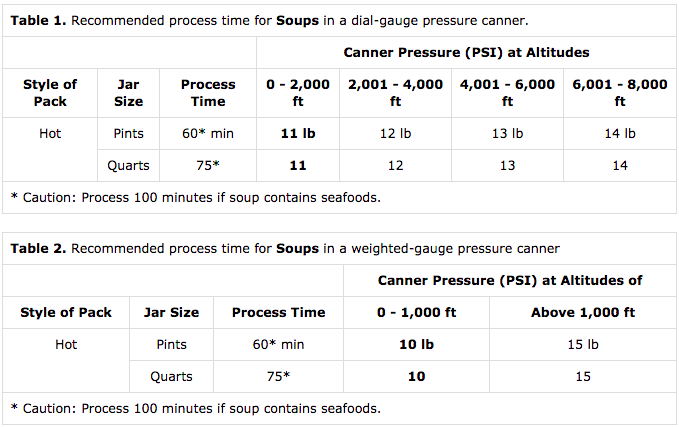
So now you’re thinking, is a half-full jar of french onion soup really the right ratio? I found it worked out really well, and it ensures that there’s enough rich flavorful beef stock in the jar to fill the bowl and absorb into the croutons at the top holding up a thick slice of gruyere on a traditional bowl of french onion soup.
I did chop the onions for this soup, rather than leaving them as whole pearl onions as in the onion canning recipe. That saves work at serving, and the longer canning time and half-filled jars ensures that heat fully penetrates the jars.
(Chopped onions are in other tested safe canning recipes, like canning beef stew, for example.)
What I wouldn’t do, is sautee the onions first. Onions really change when you sautee them for the 40-60 minutes it takes to slowly carmelize them for french onion soup, and they pack much more densely.
I found that they really packed into a thick mass at the bottom of the canning jars, and that made me think of canning pumpkin. You can’t can pumpkin puree because it’s just too thick for heat penetration, and you have to can pumpkin cubes instead.
I’d use that same logic when canning french onion soup, and just hot pack onions that have been simmered for 5 minutes in stock rather than sauteed onions.
Inside the pressure canner the onions carmelize anyway, giving a rich flavor to the home-canned french onion soup. I honestly didn’t miss all that time spent slowly sauteing onions for an hour on the stove, and I had a read made meal in a jar!
That’s my interpretation of the National Center for Food Preservation’s guidance, and that’s what I’m now doing in my house. Obviously, I’d recommend you do your own research and make your own decisions when canning at home.
Here are some good resources:
- Clemson University Guidance on Canning Onions
- National Center for Food Preservation “Can Any Soup” Recipe
- National Center for Food Preservation Soup Canning Fact Sheet
Pressure Canning Recipes
Need a few more recipes to keep your pressure canner running this season?
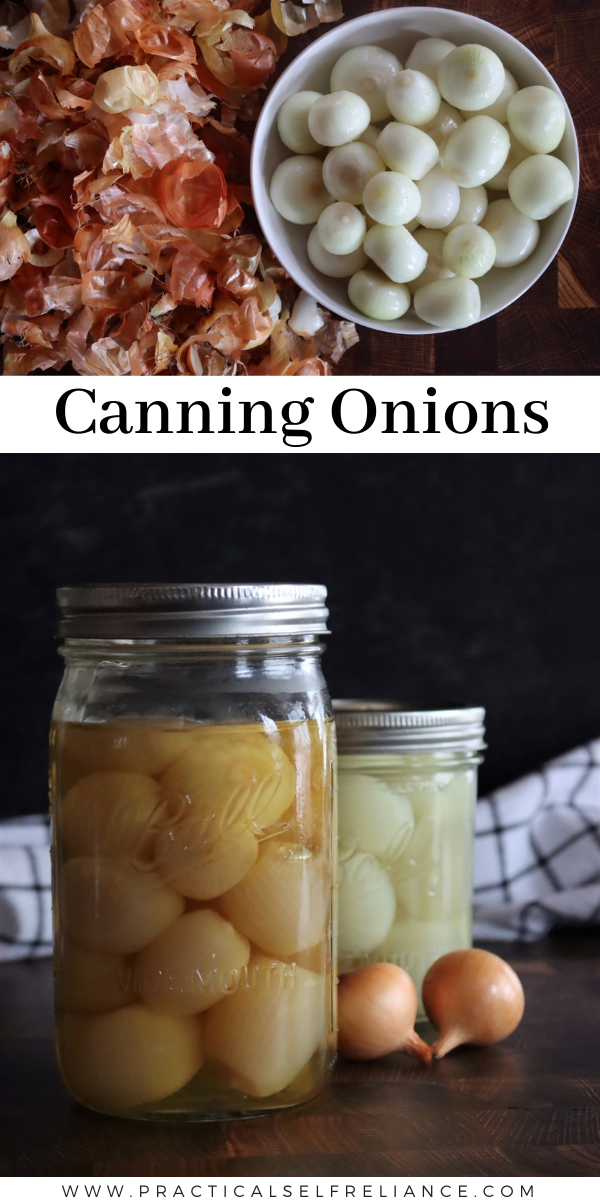
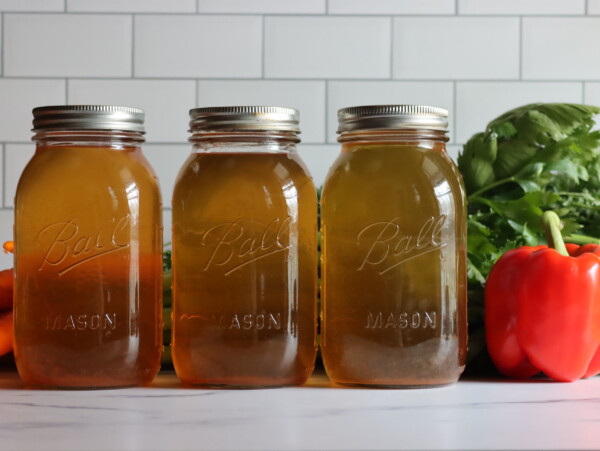
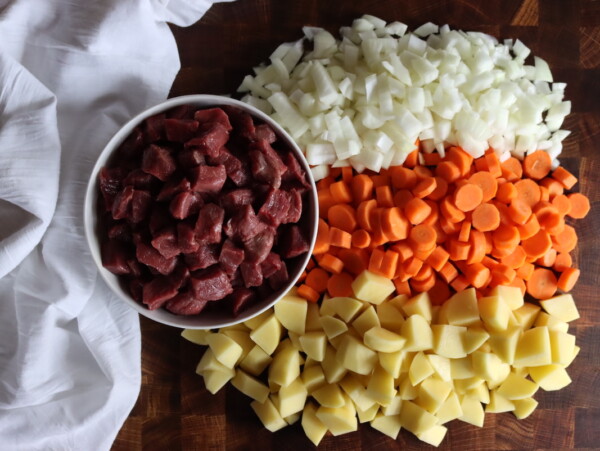
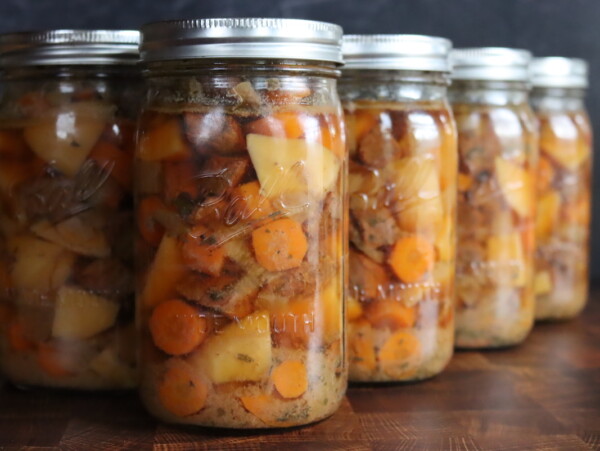











Would you check the times for pints and quarts under “instructions” ? You have the same time down for both.
I have a bunch of onions to use and this looks great, thanks!
The times for canning both pints and quarts are the same. From Clemson University, which developed the recipe:
“Process pints or quarts in a pressure canner for 40 minutes. At altitudes of 0 to 2,000 feet, process jars at 11 pounds pressure in a dial gauge canner; in a weighted gauge canner, process jars at 10 pounds pressure at altitudes of 0 to 1,000 feet and at 15 pounds pressure for altitudes above 1,000 feet.”
Hi! Thank you for this amazingly helpful article. I canned onions (raw) and when I packed the jars, I left about an inch of headspace, but when I pulled the finished jars out, there was a lot more headspace. Is that okay or is this batch ruined?
Thank you so much!
It sounds like you have experienced some siphoning. As long as the jars were properly processed and sealed they should be fine as long as you didn’t lose more than half of the liquid from the jars.
Hello,
I would like to know if I can process larger onions if I cut them into quarters before boiling for 5 minutes.
Thank you,
Beth
The tested recipes for canning onions are for onions 1 inch in diameter or smaller. As long as your pieces aren’t any bigger than that then you should be fine.
Did you ever can Vidalia ‘s?
I think I might try it with salt, vinegar and water.
Stuff them in a pint jar and cook for 20 minutes.
Vidalias can be pressure canned just like any other onion. Be sure to follow a tested method and processing time.
I did a batch of caramelized onions in the crockpot which is a great way to do them. Now I’d like to can it, but I wonder if it will be too soft? Mush?
I did a little research and found several posts written about canning carmelized onions so you should be able to do it with no problems. I even found a post where someone had caramelized them in the crock pot and then canned them.
I love all the info you share. Thank you!
You’re very welcome. So glad you’re enjoying it.
Thank you for sharing this recipe
You’re very welcome.
What did you do to the onions that did not carmelize? Did you water bath them?
Onions are a low acid food and therefore must be pressure canned. You can see the full instructions for canning the onions towards the top of the blog post. When you’re making the soup, you follow the same directions for canning the onions and rather than sauteeing them, boil them in stock for about 5 minutes.
This is so interesting, I was worried about not having enough caramelized flavor! I’m going to try a batch today 😀
Sounds great. Let us know how it turns out.
This looks wonderful. I just can’t find a real good French Onion Soup recipe. Would you have one to share and if yes can you can the soup?
If you’re wanting to can french onion soup you can just follow the instructions for canning the onions and use beef broth as the liquid in the recipe.
Loved your article on canning onion soup. I will give this a try this next canning season.